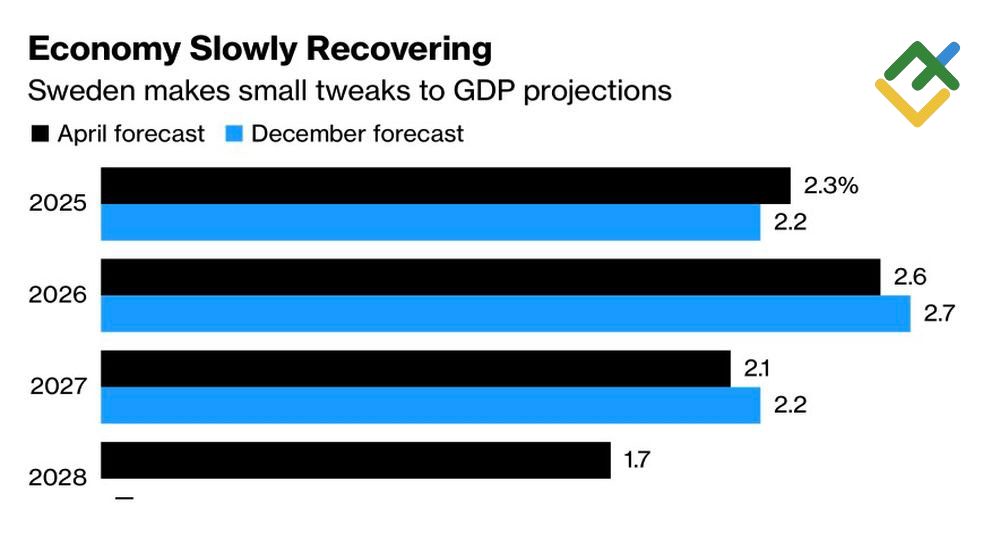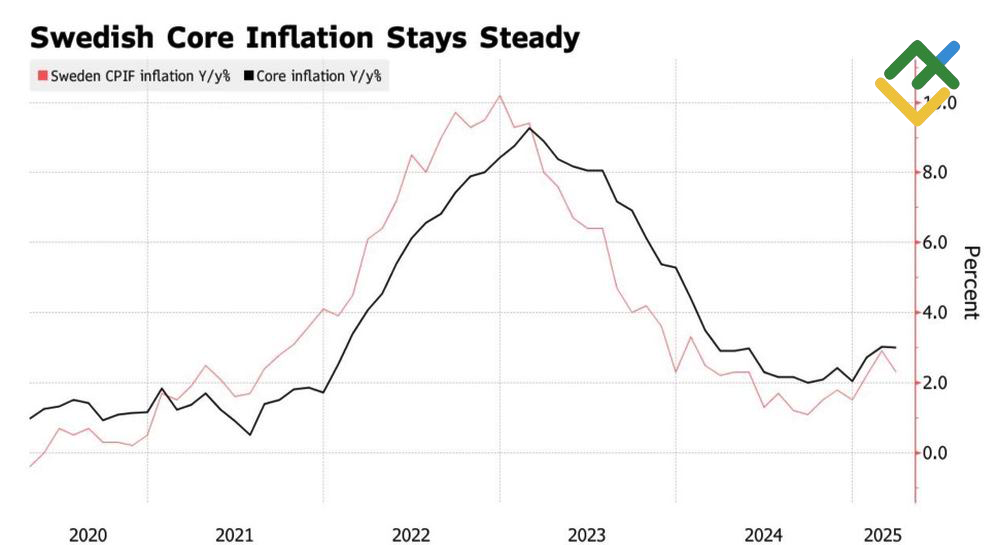
While central banks are pondering how to mitigate the negative impact of trade wars by cutting rates, the Riksbank is ready to put the brakes on the monetary expansion cycle. Together with Sweden’s accelerating GDP and the flight from the US dollar, this factor is pushing the USDSEK pair down. Let’s discuss this topic and make a trading plan.
The article covers the following subjects:
Major Takeaways
- Sweden is the primary beneficiary of the EU’s fiscal stimulus.
- Stabilized inflation allows the Riksbank to end the cycle.
- The Swedish economy will likely accelerate to 2.3% in 2025.
- Short trades on the USDSEK pair can be opened with the targets of 9 and 8.5.
Fundamental Forecast for Swedish Krona for Six Months
The Swedish krona, which has been experiencing significant economic challenges along with the Swedish economy for the past three years, has shown notable performance in 2024. It is outperforming other G10 currencies, including the Japanese yen and Swiss franc, which are currently in high demand as safe-haven assets. USDSEK bears are taking advantage of both the USD’s weakness and the EU’s fiscal stimulus.
Germany’s adjustment of the fiscal brake and increased EU defense spending have triggered the krona’s rally against major world currencies. Sweden, with its considerable share of military exports in GDP, stands to benefit the most. Swedish companies such as Saab and BAE Systems Hagglunds produce a wide range of military equipment, including fighter jets, submarines, support weapons, and combat vehicles.
As a result, the government has revised its economic growth forecast for 2025 to 2.3%, marking a substantial increase from the +1% projected for 2024. The government’s fiscal stimulus, in the form of tax cuts for households, will also boost GDP. Despite this, the fiscal deficit is expected to narrow from 1.5% to 0.8% due to robust GDP growth. A surplus is anticipated in 2026, and the strengthening of public finances is another reason to acquire the krona.
Forecasts for Swedish Economy
Source: Bloomberg.
The Riksbank has been compelled to reduce the key rate by a total of 175 basis points to 2.25% on six separate occasions due to the prevailing economic weakness. However, the stabilization of inflation below forecasts at 3% in March and the strengthening of the Swedish currency by 13.5% against the US dollar and almost 4% against the euro since the beginning of the year indicate that the central bank can take its time. The country’s financial regulator has no plans to adjust monetary policy until at least 2027. In light of the global trend of regulators resorting to monetary stimulus to bolster their economies amid the ongoing trade wars, this represents another compelling reason to consider acquiring the krona.
Swedish Core Inflation Change
Source: Bloomberg.
Notably, record speculative long positions were opened on the Swedish currency. This, along with the traditional capital outflow from the Swedish stock market due to dividend payments by companies, could have led to a correction in the USDSEK pair. However, this did not occur, underscoring the investors’ strong demand for the krona. According to the SEB survey, the euro is projected to weaken from its current exchange rate of 11 to 10.5 against the Swedish currency by the end of 2025.
Trading Plan for USDSEK for Six Months
The acceleration of the Swedish economy, the Riksbank’s reluctance to adjust the monetary policy, and the loss of investor confidence in the US dollar are among the reasons why the USDSEK pair will likely continue to slide. Traders may explore selling opportunities once the pair rebounds from resistance levels of 9.7 and 9.8 or if the quotes drop below a support level of 9.49. Bearish targets are located at 9 and 8.5.
This forecast is based on the analysis of fundamental factors, including official statements from financial institutions and regulators, various geopolitical and economic developments, and statistical data. Historical market data are also considered.
Price chart of USDSEK in real time mode
The content of this article reflects the author’s opinion and does not necessarily reflect the official position of LiteFinance broker. The material published on this page is provided for informational purposes only and should not be considered as the provision of investment advice for the purposes of Directive 2014/65/EU.
According to copyright law, this article is considered intellectual property, which includes a prohibition on copying and distributing it without consent.
{{value}} ( {{count}} {{title}} )
This post is originally published on LITEFINANCE.







